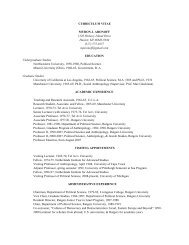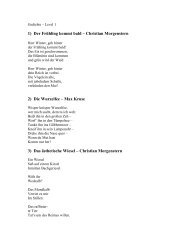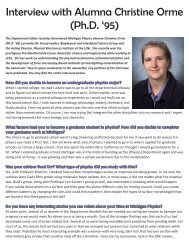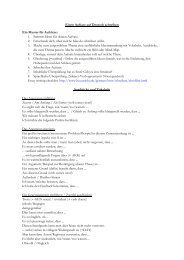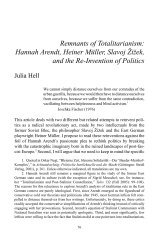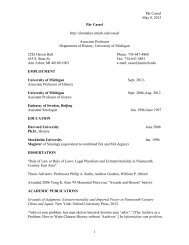Remember the Hand: Bodies and Bookmaking in Early Medieval ...
Remember the Hand: Bodies and Bookmaking in Early Medieval ...
Remember the Hand: Bodies and Bookmaking in Early Medieval ...
You also want an ePaper? Increase the reach of your titles
YUMPU automatically turns print PDFs into web optimized ePapers that Google loves.
Downloaded by [ca<strong>the</strong>r<strong>in</strong>e brown] at 13:48 24 October 2011<br />
In fact, <strong>the</strong>y do, <strong>and</strong> to <strong>the</strong> letter: that note written with a bad pen records<br />
<strong>the</strong> copy<strong>in</strong>g process of this particular manuscript of De civitate Dei, which is <strong>in</strong><br />
fact copiously annotated with milestones that track <strong>the</strong> construction of <strong>the</strong><br />
text, column by column, <strong>and</strong> page by page. Alongside August<strong>in</strong>e’s titanic<br />
<strong>the</strong>ological chronology, Real Academia de la Historia MS. 29 offers <strong>the</strong><br />
marg<strong>in</strong>al story of its own production (table 1).<br />
The same h<strong>and</strong> that does not like its pen makes o<strong>the</strong>r entries, occasionally<br />
reassur<strong>in</strong>g readers about <strong>the</strong> text’s reliability (f. 128v.: ‘‘I checked it, trust me,<br />
noth<strong>in</strong>g’s miss<strong>in</strong>g’’ [‘‘Perexi, non dubites, nil m<strong>in</strong>us habet’’]), sometimes<br />
comment<strong>in</strong>g learnedly upon it (or transcrib<strong>in</strong>g someone else’s learned comments),<br />
often simply not<strong>in</strong>g a date <strong>and</strong> even a time (f. 134v: ‘‘Vespera sanctarum<br />
Iuste et Ruf<strong>in</strong>e’’ = Eve of Sa<strong>in</strong>ts Justa <strong>and</strong> Ruf<strong>in</strong>a, July 16).<br />
One writer who so marks his time is named Moterrafe, though to figure this<br />
out we have to crack <strong>the</strong> little puzzle he leaves <strong>in</strong> <strong>the</strong> marg<strong>in</strong> of f. 170v<br />
(figure 2): two columns of t<strong>in</strong>y letters. Rotate figure 2 90 degrees counterclockwise.<br />
Beg<strong>in</strong> with <strong>the</strong> capital E, bottom row, far left. Above it, F.<br />
Diagonally down to <strong>the</strong> right, bottom row: A. Above it, R. And so on:<br />
‘‘EFARRTOM MUNOCAID AIROMEM.’’<br />
Read it backwards, <strong>and</strong> you will never forget him: MEMORIA DIACONUM<br />
MOTERRAFE: ‘‘<strong>Remember</strong> Moterrafe <strong>the</strong> deacon.’’ On f. 196r, <strong>the</strong> h<strong>and</strong><br />
changes; 80 folios later, we get a name for <strong>the</strong> new h<strong>and</strong> <strong>and</strong> ano<strong>the</strong>r<br />
rem<strong>in</strong>der, this time laid out as a monogram (f. 273v): ALOITII PRESBITERI<br />
MEMORIA: ‘‘<strong>Remember</strong> Aloysius <strong>the</strong> presbyter’’ figure 3.<br />
And on f. 276v, we are told ‘‘Here Aloysius <strong>the</strong> presbyter stopped writ<strong>in</strong>g’’<br />
[‘‘Hic cessavit Aloitius presbiter de scribere’’] (figure 4) <strong>and</strong> Moterrafe’s h<strong>and</strong><br />
returns.<br />
In sum: sixteen dates <strong>and</strong> three scribes – one unnamed, one named twice<br />
<strong>and</strong> one three times. 16 So as we follow August<strong>in</strong>e’s argument <strong>in</strong> City of God,we<br />
also follow <strong>the</strong> growth of <strong>the</strong> book that conta<strong>in</strong>s it. 17 We track <strong>the</strong> work that<br />
makes <strong>the</strong> Work. Read for <strong>the</strong> mean<strong>in</strong>g, but remember <strong>the</strong> pen, <strong>the</strong> manuscripts<br />
tell us.<br />
Appropriately enough, <strong>the</strong> most spectacular <strong>in</strong>vitation to ignore Gregory’s<br />
advice aga<strong>in</strong>st read<strong>in</strong>g <strong>the</strong> text but ask<strong>in</strong>g about <strong>the</strong> pen comes from <strong>the</strong> h<strong>and</strong><br />
of a scribe who really, one would th<strong>in</strong>k, ought to know better. I say ‘‘ought to<br />
know better’’ because <strong>the</strong>re is no doubt that <strong>the</strong> scribe <strong>in</strong> question had read<br />
Gregory’s warn<strong>in</strong>g. Not only did he read it, but he <strong>in</strong>corporated it <strong>in</strong> <strong>the</strong> most<br />
<strong>in</strong>timate medieval way possible: he copied it carefully on <strong>the</strong> recto of f. 18 of a<br />
spectacular manuscript of <strong>the</strong> Moralia---which, <strong>the</strong> scribe will also tell us on f.<br />
499r, he completed around 6 AM on April 11 th , 945.<br />
Florentius’s <strong>H<strong>and</strong></strong> (Madrid, Biblioteca Nacional de España, MS 80)<br />
He who does not write <strong>the</strong> earth with <strong>the</strong> plow must pa<strong>in</strong>t <strong>the</strong> page with his<br />
f<strong>in</strong>ger. (Ferreolus of Uzès, d. 581 CE)<br />
The sumptuously decorated copy of <strong>the</strong> Moralia that now resides <strong>in</strong> <strong>the</strong><br />
Biblioteca Nacional <strong>in</strong> Madrid as MS 80 was executed at <strong>the</strong> Castilian<br />
monastery of Valeránica by one h<strong>and</strong>, text <strong>and</strong> image alike---no mean feat,<br />
s<strong>in</strong>ce <strong>the</strong> codex runs to 501 folios <strong>and</strong> measures a massive 490 x 350 mm (19¼"<br />
x13 3 /4"). Mak<strong>in</strong>g it must have taken him a very long time <strong>in</strong>deed. The scribe’s<br />
name was Florentius, <strong>and</strong> he is noth<strong>in</strong>g if not engaged with his work. 18<br />
266 CATHERINE BROWN<br />
Figure 1. Madrid, Real Academia de la<br />
Historia, MS 29, f. 106r (detail). ‘‘I wrote here<br />
on <strong>the</strong> Sunday after Ascension, <strong>and</strong> <strong>the</strong> pen was<br />
bad’’ [Hic scripsi <strong>in</strong> dom<strong>in</strong>ico post ascensio et<br />
fuit illa p<strong>in</strong>na mala].<br />
16 – The record of scribes <strong>and</strong> dates is only<br />
part of <strong>the</strong> copious annotation left <strong>in</strong> <strong>the</strong><br />
manuscript by its copyists---also <strong>in</strong>cluded are<br />
<strong>in</strong>terpretive <strong>and</strong> critical notes. For a more<br />
detailed discussion, see Díaz y Díaz, Libros y<br />
librerías, pp. 147-54 <strong>and</strong> Díaz y Díaz, ‘‘El cultivo<br />
del latín en el siglo X,’’ Anuario de estudios<br />
filológicos 4 (1981), pp. 71-81.<br />
17 – The practice of multiple scribes not<strong>in</strong>g <strong>the</strong>ir<br />
parts <strong>in</strong> <strong>the</strong> production of a s<strong>in</strong>gle manuscript <strong>in</strong><br />
this period is rare, but not undocumented---<strong>the</strong><br />
most strik<strong>in</strong>g examples from <strong>the</strong> early period are<br />
<strong>the</strong> August<strong>in</strong>e codices made by <strong>the</strong> nuns of<br />
Chelles <strong>in</strong> <strong>the</strong> tenth <strong>and</strong> eleventh centuries. On<br />
this <strong>and</strong> similar cases, see Jean Vez<strong>in</strong>, ‘‘La<br />
repartition du travail dans les scriptoria carol<strong>in</strong>giens,’’<br />
Journal des Savants 3 (1973), pp. 212-37.<br />
Christopher De Hamel offers a late twelfthcentury<br />
English glossed Exodus (Lambeth<br />
Palace Library, MS 110) with notes by <strong>the</strong> scribe<br />
track<strong>in</strong>g a copy<strong>in</strong>g work week, beg<strong>in</strong>n<strong>in</strong>g on<br />
‘‘lundi’’ <strong>and</strong> end<strong>in</strong>g twelve leaves later on<br />
‘‘samadi’’ (A History Of Illum<strong>in</strong>ated Manuscripts<br />
[London: Phaidon Press, 1997], p. 92). Closest to<br />
our Iberian case is a manuscript from St Vaast<br />
which bears names of n<strong>in</strong>e scribes work<strong>in</strong>g <strong>in</strong><br />
twelve st<strong>in</strong>ts; see Richard Gameson, ‘‘‘Signed’<br />
Manuscripts From <strong>Early</strong> Romanesque<br />
Fl<strong>and</strong>ers: Sa<strong>in</strong>t-Bert<strong>in</strong> <strong>and</strong> Sa<strong>in</strong>t-Vaast,’’ <strong>in</strong> Pen<br />
<strong>in</strong> <strong>H<strong>and</strong></strong>: <strong>Medieval</strong> Scribal Portraits, Colophons <strong>and</strong><br />
Tools, ed. Michael Gullick (Walkern, Herts.:<br />
Red Gull Press, 2006), pp. 31-73.<br />
18 – Key works on Valeránica <strong>in</strong> <strong>the</strong> period<br />
<strong>and</strong> Florentius <strong>in</strong> particular: Manuel C. Díaz<br />
yDíaz, ‘‘El escriptorio de Valeránica,’’ <strong>in</strong><br />
Codex Biblicus Legionensis: Ve<strong>in</strong>te estudios (León:<br />
Real Colegiata de San Isidoro, 1999), pp. 53-<br />
72; Barbara A. Shailor, ‘‘The Scriptorium of<br />
San Pedro de Berlangas’’ (PhD <strong>the</strong>sis,<br />
University of C<strong>in</strong>c<strong>in</strong>nati, 1975); X. Huidobro<br />
y Serna, ‘‘El monasterio de San Pedro de<br />
Berlangas en Tordómar y su celebre calígrafo<br />
el monje Florencio,’’ Boletín de la Comisión de<br />
Monumentos de Burgos 14 (1935), pp. 45-47; John<br />
Williams, ‘‘A Contribution to <strong>the</strong> History of<br />
<strong>the</strong> Castilian Monastery of Valeranica <strong>and</strong><br />
<strong>the</strong> Scribe Florentius,’’ Madrider Mitteilungen<br />
11(1970), pp. 231-48.







